 |
Phil tracing the wiring for the old engine room bilge pump |
The scary experience of trying to sleep on a boat with a steady flow of water coming in turned fitting an automatic bilge pump into our top priority.
We also have a 24V manually switched bilge pump and another automatic one will be fitted very soon.
Fitting a new bilge pump
We’d been planning to swap the manual bilge pumps on our 43ft cruiser Ravensdale for automatic ones for some time, but there always seemed to be another job that was more pressing.
That all changed the night Phil had to get up every two hours during the night to operate the bilge pump when the stern gland on the port prop shaft developed a fairly serious leak. And, yes, I know we should have taken turns, but he volunteered J
The leak developed after we took our Neptunus 133 out cruising on two consecutive days - Winter cruising joys and the misery caused by flooding bilges
Unfortunately we discovered the rising water level in the engine room quite late in the day and Phil was reluctant to touch it while the boat was in the water in case he made the leak worse.
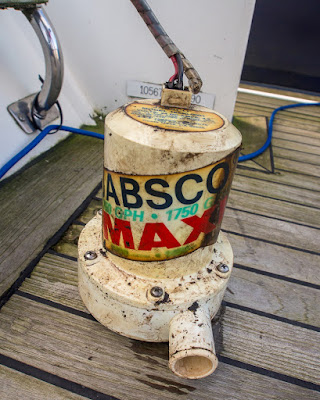 |
The manual pump that is being relocated to the bow bilges |
This meant we had to wait until the following morning to get help.
It turned out it was just a case of tightening the nuts on the stern gland plate so we'll know what to do if it happens again.
At the same time as discovering the leak, we found out that the bow bilge pump was no longer working so we immediately ordered a new one.
We decided to move the working manual pump in the engine room into the bow bilges and put a new larger automatic pump in the engine room.
After checking the various options online, we went for the 24V Rule-Mate 2000, which can pump 2000 gallons per hour.
 |
Ravensdale's new automatic bilge pump |
Phil then set about trying to work out how to get the cables from the switch on the helm console to the bilge pump in the engine room.
The existing cables could not be used as there were only two, when three were now needed, and they were not in particularly good condition.
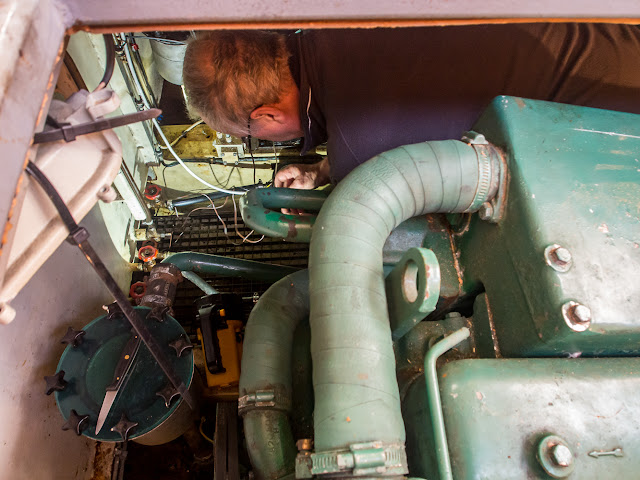 |
Phil preparing the wiring for the new bilge pump in the engine room |
 |
The three-way switch for the new bilge pump |
He also fitted the new pump in a more accessible position as the original had been under the diesel tank and at arm’s length from the end of the walkway in the engine room.
It was such a tight spot that Phil asked me to be ready to pull him out by his feet if he got stuck. Thankfully that wasn’t necessary.
And we now have a fully functioning automatic bilge pump in the engine room.
Phil poured water into the bilges with a hosepipe to test it and the pump kicked in when it reached the required level.
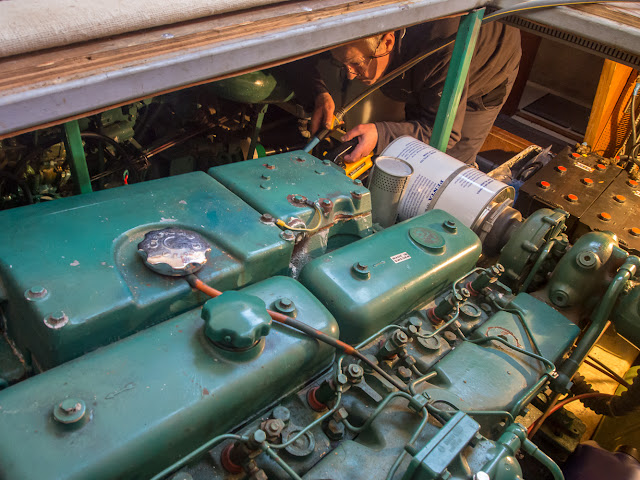 |
Phil pouring water into the engine room bilges |
Creaking mooring ropes
Our latest trips out to sea also created another far less worrying but fairly annoying problem – very creaky mooring ropes.
 |
Phil adjusting one of the creaking mooring ropes |
However, for some reason it didn’t work this time. We tied and retied them a number of times, but still the loud creaking continued to keep us awake at night.
In desperation, Phil poured washing up liquid over the ropes on the cleat nearest our cabin one night and they seemed to quieten down a bit.
The next morning we could see streaks of the yellow washing up liquid on the side of the boat, which have since been washed off, but the ropes still seem to be quieter than they were before it was applied so we’ll know what to do next time J
Patching the flybridge cover
 |
Me sewing a patch on our torn flybridge cover |
Meanwhile, I attempted to patch a tear in the canvas cover for the flybridge, which proved much more difficult than I’d expected.
I wasn’t convinced my domestic sewing machine would be up to sewing through the thick canvas, but that proved less of a problem than manoeuvring the bulk of the cover through the machine while turning it round to stitch the four sides of the patch.
I broke the only needle I had that was supposed to be able to handle heavy fabric and had to resort to a leather needle to finish the task.
It’s not the neatest sewing job I’ve ever done, but it has stopped the rain getting in.
Unfortunately, I couldn’t get fabric that was an exact match for the existing cover, but at least the Sunbrella patch is blue and, more importantly, waterproof.
 |
Ravensdale's patchwork effect flybridge cover |
There are so many patches on it now that it’s beginning to look like a patchwork quilt so I think a new one may be needed before too long.
However, after the trouble I had trying to sew on a simple patch with my machine, I doubt I’ll attempt making a new one. I’ll probably leave that to the professionals.
Feathered friends
The pair of swans that frequent the marina have been around looking for food again while the berth holder who used to feed them has been away.
 |
The pair of swans in search of food |
And the little black and white duck that we first saw back in December of last year was a regular visitor for a couple of days during the past week.
We previously looked it up to find out what type of duck it was and learned that it was a lightweight domesticated breed called a magpie duck.
Keen to find out more now it seemed to be here to stay, I looked it up again to find out whether it was male or female. It turned out to be male because it has curly feathers just above its tail.
On Friday evening, we found him in the water near our boat quacking at us whenever he saw us. We took pity on him and gave his some bread.
 |
The magpie duck on the pontoon by our boat |
He was back the following day when we saw him sitting on the pontoon by our steps waiting for us to come out so we tried giving him some bird food we had on board and he stayed around for much of the day.
He seemed to get tamer each time we saw him, running along the pontoon towards us if we called him, but was unwilling to take food directly from us.
On Sunday, he arrived earlier and stayed for most of the day. He allowed us to get closer than before, but still shied away if we got too close.
But, on Monday, he started eating from the palm of my hand.
 |
The first time the duck ate out of my hand |
I was all set to give him a name and declare him our new pet when the marina staff, who had started pressure washing the pontoons the previous day, reached our pontoon.
 |
One of the marina staff pressure washing the pontoons |
The duck flew off and hasn’t been back since. Hopefully he’ll return very soon as I was getting used to having him around.
I recently learnt that anatidaephobia is the fear of being watched by a duck, swan or goose. I wonder if there’s a name for the fear of NOT being watched by a duck J
Windy weather
We’ve had a pretty cold week here with some frosty mornings. The temperature has just about managed to stay above 0C (32F) but strong winds have made it feel a lot colder.
And there has been a LOT of wind over the past week so no chance of taking the boat out.
 |
Me checking the wind speed with our anemometer |
Low temperatures are fine, but we prefer not to leave the marina if the wind speed is higher than a single figure.
And on many days it would not even have been possible to do so as the marina doesn’t open the gate if there’s too much swell and it has stayed closed on a number of occasions this week.
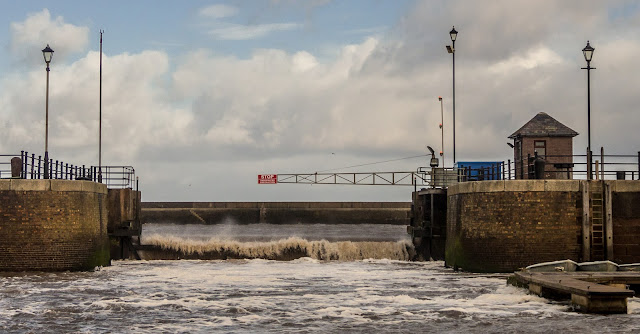 |
Water pouring over the closed marina gate |
Last Friday was cold and sunny so I took my camera for a walk around the local area.
 |
The sun setting behind clouds over the Solway Firth in Cumbria |
 |
Maryport Marina - Ravensdale is just visible in the far right corner of the marina |
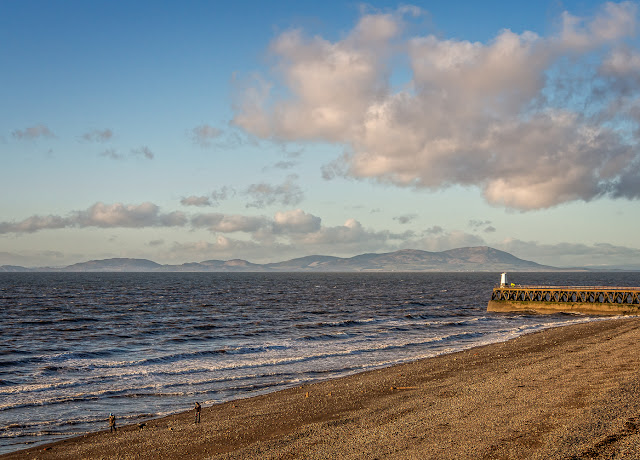 |
Grasslot shore at Maryport with with the Scottish hills in the distance |
 |
A wider view of Maryport Marina |
Saturday, Sunday and Monday were also very chilly with high winds.
Tuesday was still cold, with rain, sleet and wet snow in the morning and sunshine in the afternoon, which provided another opportunity for a walk with my camera. The snow started falling again as I got back to the boat.
 |
Maryport in Cumbria from Mote Hill with the Scottish hills in the distance |
 |
Blue bridge crossing the River Ellen at Maryport |
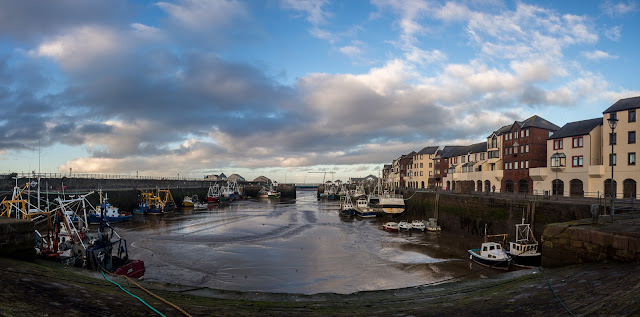 |
Maryport Harbour |
 |
Maryport Marina just before the snow arrived on Tuesday afternoon |
Valentine’s Day followed a very cold and windy night with a highest average wind speed of 36mph, gusting up to 48mph, recorded at nearby St Bee’s Head.
The high winds continued throughout the day on Wednesday, peaking late morning with a top average speed of 40mph and gusts up to 57mph.
Yesterday (Thursday) the wind continued to blow throughout the day with the highest average wind speed of 31mph and gusts of up to 44mph recorded at 1pm.
Last night and today (Friday) have also been very windy, but at least the sun's shining today and it's a bit warmer at around 6-7C (43-44F).
So glad we eventually managed to get our mooring ropes to stop creaking or we would’ve been totally shattered due to lack of sleep after such a windy week.
Last night and today (Friday) have also been very windy, but at least the sun's shining today and it's a bit warmer at around 6-7C (43-44F).
So glad we eventually managed to get our mooring ropes to stop creaking or we would’ve been totally shattered due to lack of sleep after such a windy week.
New neighbour
Last night (Thursday) we had a new neighbour for the night.
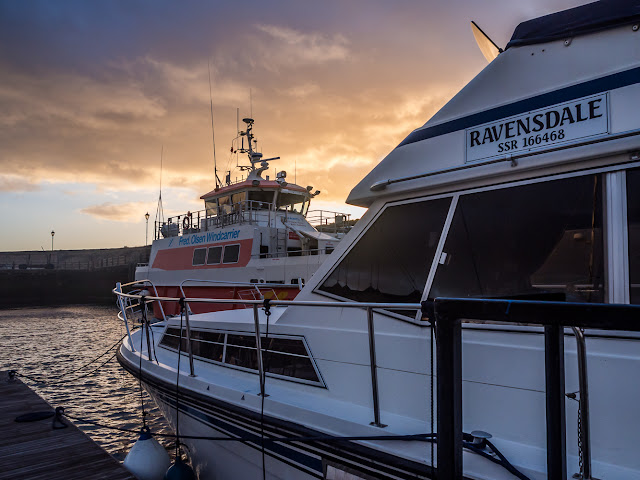 |
The Bayard 7 moored on the harbour wall opposite Ravensdale |
The Fred. Olsen Windcarrier Bayard 7 has been on the marina slipway having work carried out by the local boat yard for the past fortnight.
It went back in the water yesterday afternoon and was moored up on the harbour wall almost opposite Ravensdale, but it was only there overnight and left when the marina gate opened this morning.
No comments:
Post a Comment